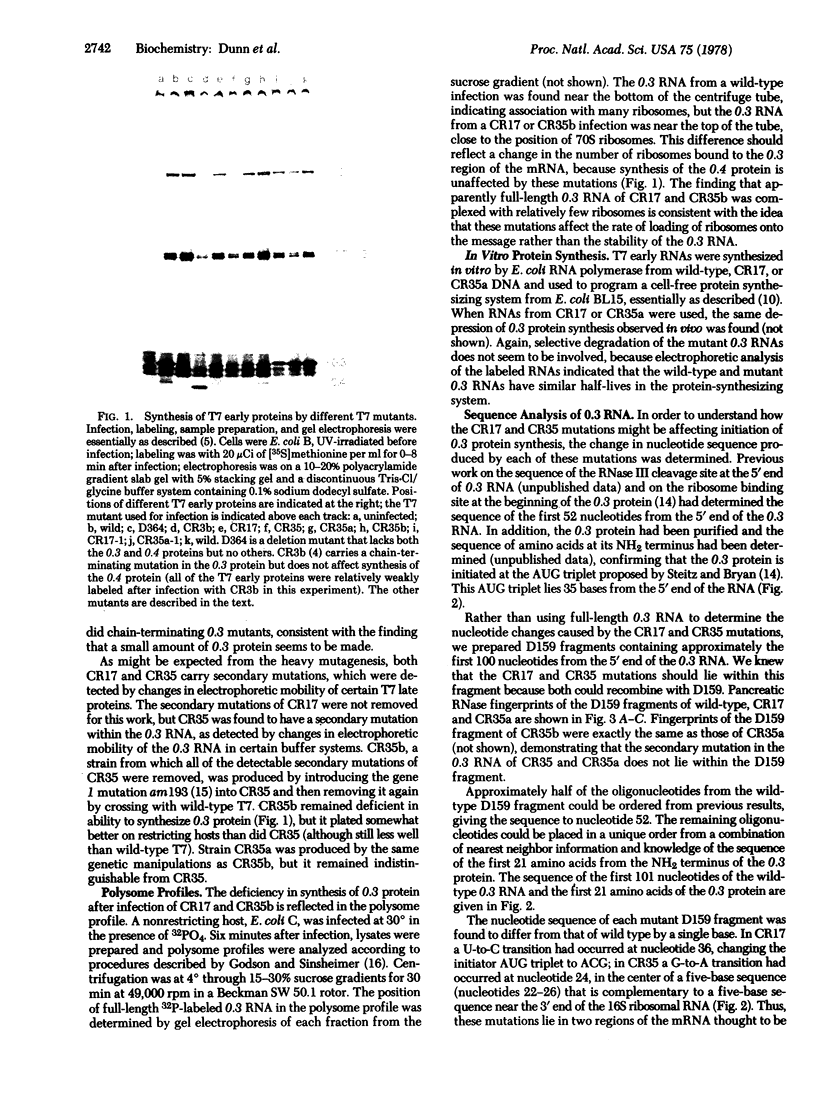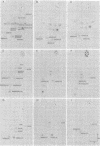Abstract
Two different mutations that greatly diminish the rate of synthesis of the gene 0.3 protein of bacteriophage T7 have been characterized. One is in the initiator triplet for the 0.3 protein, changing it from AUG to ACG. This mutation was found to have little effect on binding of ribosomes to the 0.3 mRNA in vitro, although 0.3 protein synthesis was greatly depressed in vitro as well as in vivo. A suppressor mutation that partially restores the wild-type rate of synthesis was found to lie within the 0.3 RNA but not close to the mutant ACG (more than 64 nucleotides away). The second mutation is a G-to-A transition located 11 bases to the 5′ side of the initiator AUG. This change eliminates a possible five-base pairing with a sequence near the 3′ end of 16S ribosomal RNA, an interaction previous workers have proposed to be important for initiation of protein synthesis. This mutation causes the site of ribosome binding to shift about 15 bases to the 3′ side, centering on an internal AUG, but this new site has only a poor potential interaction with 16S RNA. A suppressor mutation that restores the rate of 0.3 protein synthesis to essentially wild-type levels and also restores wild-type ribosome-binding behavior was found to lie adjacent to the original mutation, creating a new four-base complementarity with 16S RNA. These results provide strong support for the idea that a pairing interaction between mRNA and 16S RNA is involved in specific initiation of protein synthesis in Escherichia coli and indicate that this interaction may be important in selecting the site in mRNA at which the ribosomes bind.
Keywords: mRNA-rRNA interaction, Shine-Dalgarno model, initiator AUG, RNA sequence analysis, ribosome binding
Full text
PDF




Images in this article
Selected References
These references are in PubMed. This may not be the complete list of references from this article.
- Anderson C. W., Atkins J. F., Dunn J. J. Bacteriophage T3 and T7 early RNAs are translated by eukaryotic 80S ribosomes: active phage T3 coded S-adenosylmethionine cleaving enzyme is synthesized. Proc Natl Acad Sci U S A. 1976 Aug;73(8):2752–2756. doi: 10.1073/pnas.73.8.2752. [DOI] [PMC free article] [PubMed] [Google Scholar]
- Barnes W. N., Reznikoff W. S. The isolation of RNA homologous to the genetic control elements of the lactose operon. J Biol Chem. 1975 Oct 25;250(20):8184–8192. [PubMed] [Google Scholar]
- Dunn J. J. RNase III cleavage of single-stranded RNA. Effect of ionic strength on the fideltiy of cleavage. J Biol Chem. 1976 Jun 25;251(12):3807–3814. [PubMed] [Google Scholar]
- Dunn J. J., Studier F. W. Effect of RNAase III, cleavage on translation of bacteriophage T7 messenger RNAs. J Mol Biol. 1975 Dec 15;99(3):487–499. doi: 10.1016/s0022-2836(75)80140-9. [DOI] [PubMed] [Google Scholar]
- Godson G. N., Sinsheimer R. L. Use of Brij lysis as a general method to prepare polyribosomes from Escherichia coli. Biochim Biophys Acta. 1967 Dec 19;149(2):489–495. doi: 10.1016/0005-2787(67)90176-1. [DOI] [PubMed] [Google Scholar]
- Kerr C., Sadowski P. D. Gene 6 exonuclease of bacteriophage T7. II. Mechanism of the reaction. J Biol Chem. 1972 Jan 10;247(1):311–318. [PubMed] [Google Scholar]
- Shine J., Dalgarno L. The 3'-terminal sequence of Escherichia coli 16S ribosomal RNA: complementarity to nonsense triplets and ribosome binding sites. Proc Natl Acad Sci U S A. 1974 Apr;71(4):1342–1346. doi: 10.1073/pnas.71.4.1342. [DOI] [PMC free article] [PubMed] [Google Scholar]
- Simon M. N., Studier F. W. Physical mapping of the early region of bacteriophage T7 DNA. J Mol Biol. 1973 Sep 15;79(2):249–265. doi: 10.1016/0022-2836(73)90004-1. [DOI] [PubMed] [Google Scholar]
- Steitz J. A., Bryan R. A. Two ribosome binding sites from the gene 0-3 messenger RNA of bacteriophages T7. J Mol Biol. 1977 Aug 25;114(4):527–543. doi: 10.1016/0022-2836(77)90176-0. [DOI] [PubMed] [Google Scholar]
- Steitz J. A., Jakes K. How ribosomes select initiator regions in mRNA: base pair formation between the 3' terminus of 16S rRNA and the mRNA during initiation of protein synthesis in Escherichia coli. Proc Natl Acad Sci U S A. 1975 Dec;72(12):4734–4738. doi: 10.1073/pnas.72.12.4734. [DOI] [PMC free article] [PubMed] [Google Scholar]
- Steitz J. A. Polypeptide chain initiation: nucleotide sequences of the three ribosomal binding sites in bacteriophage R17 RNA. Nature. 1969 Dec 6;224(5223):957–964. doi: 10.1038/224957a0. [DOI] [PubMed] [Google Scholar]
- Studier F. W. Analysis of bacteriophage T7 early RNAs and proteins on slab gels. J Mol Biol. 1973 Sep 15;79(2):237–248. doi: 10.1016/0022-2836(73)90003-x. [DOI] [PubMed] [Google Scholar]
- Studier F. W. Gene 0.3 of bacteriophage T7 acts to overcome the DNA restriction system of the host. J Mol Biol. 1975 May 15;94(2):283–295. doi: 10.1016/0022-2836(75)90083-2. [DOI] [PubMed] [Google Scholar]
- Studier F. W. The genetics and physiology of bacteriophage T7. Virology. 1969 Nov;39(3):562–574. doi: 10.1016/0042-6822(69)90104-4. [DOI] [PubMed] [Google Scholar]




